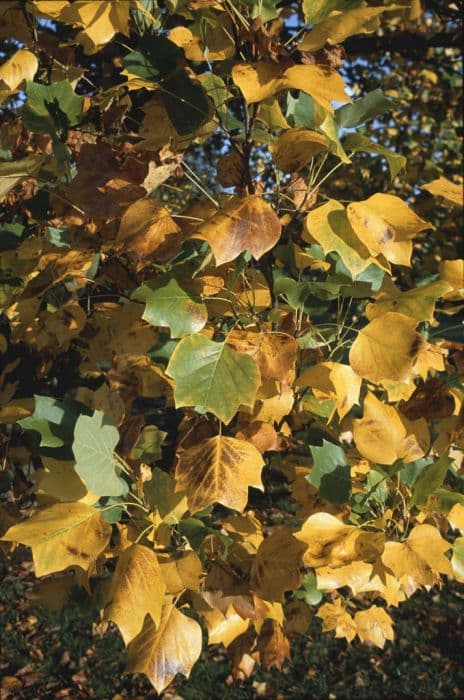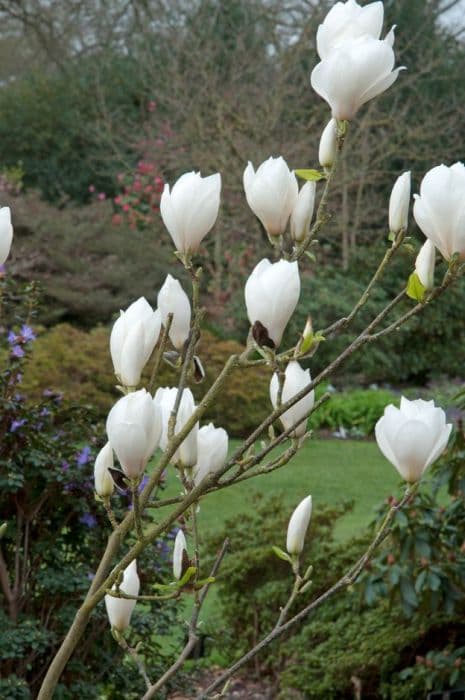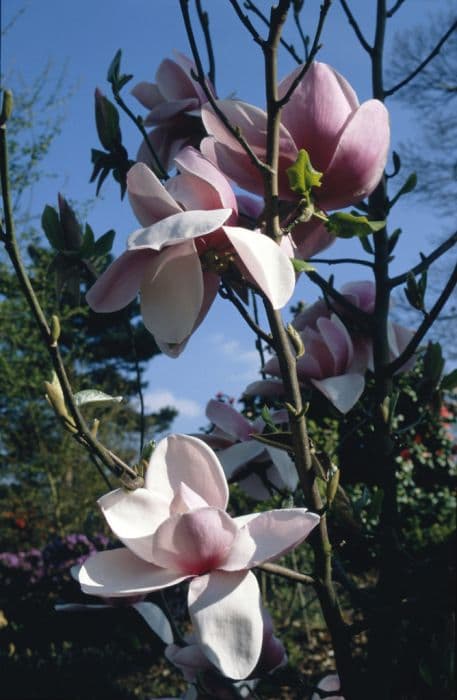Loebner Magnolia Magnolia × loebneri 'Wildcat'

ABOUT
The Magnolia 'Wildcat' is a striking ornamental plant admired for its floral display. It showcases a proliferation of flowers that are a beautiful blend of pale pink to purplish-pink on the outside, while the inside reveals a softer, creamy white to light pink hue. The flowers are star-shaped with multiple slender petals, giving them a distinctive and elegant appearance. They emerge before the leaves in early spring, which adds to the visual impact as the blossoms stand out against the bare branches. The leaves of the 'Wildcat' are glossy and green, providing a lush backdrop to the flowers during the blooming period. As the seasons change, the foliage can acquire golden yellow hues, adding autumn interest to the plant. The overall form of the Magnolia 'Wildcat' is typically multi-stemmed, contributing to a rounded and full appearance. The bark is smooth and adds a subtle textural contrast to the softness of the flowers and leaves.
About this plant
 Names
NamesFamily
Magnoliaceae
Synonyms
Loebner Magnolia, Wildcat Magnolia
Common names
Magnolia × loebneri 'Wildcat'.
 Toxicity
ToxicityTo humans
The Loebner magnolia is not known to be toxic to humans. However, as with any plant, individual allergies or sensitivities could cause reactions in some people. If any part of the plant is ingested in large amounts, it could potentially cause stomach discomfort or an adverse reaction due to the individual's unique sensitivities.
To pets
The Loebner magnolia is not known to be toxic to pets. It is generally considered safe around pets such as dogs and cats. However, ingestion of large quantities could potentially cause mild gastrointestinal upset due to the physical nature of plant material rather than toxicity. If a pet shows signs of distress after ingesting part of the plant, it is advisable to consult a veterinarian.
 Characteristics
CharacteristicsLife cycle
Perennials
Foliage type
Deciduous
Color of leaves
Green
Flower color
Pink
Height
15-20 feet (4.57-6.10 meters)
Spread
10-15 feet (3.05-4.57 meters)
Plant type
Tree
Hardiness zones
5-9
Native area
Cultivar
Benefits
 General Benefits
General Benefits- Aesthetic Appeal: Adds visual interest to gardens with its beautiful blossoms and attractive form.
- Attracts Wildlife: Provides nectar for pollinators such as bees and can attract birds to the garden.
- Seasonal Interest: Offers early spring flowers, often before other plants begin to bloom, adding color after winter.
- Durability: Known for being hardy and able to withstand cold temperatures once established.
- Low Maintenance: Requires minimal pruning and care compared to other ornamental plants.
- Shade Provider: As it matures, it can offer shade to smaller plants or seating areas in the garden.
 Medical Properties
Medical PropertiesThis plant is not used for medical purposes.
 Air-purifying Qualities
Air-purifying QualitiesThis plant is not specifically known for air purifying qualities.
 Other Uses
Other Uses- Magnolia 'Wildcat' petals can be crystallized and used as edible decorations for cakes and desserts.
- The sturdy wood of Magnolia 'Wildcat' can be used for small woodworking projects like making picture frames or decorative boxes.
- Fallen Magnolia 'Wildcat' leaves can be gathered and layered to create a natural mulch for garden beds.
- The bark of Magnolia 'Wildcat' can be carefully harvested and used in small-scale crafting, such as the creation of natural jewelry.
- Dried Magnolia 'Wildcat' seed pods can be incorporated into floral arrangements or used as rustic table centerpieces.
- Magnolia 'Wildcat' branches can be pruned and shaped into living fences or garden borders for both privacy and aesthetic appeal.
- Large Magnolia 'Wildcat' leaves can serve as a natural wrapping material for protecting delicate items or as organic dishware for outdoor dining events.
- The cones from Magnolia 'Wildcat' can be used during the holiday season as natural ornaments or in wreaths and garlands.
- Landscape artists sometimes use the overall shape and branching pattern of Magnolia 'Wildcat' trees to create distinctive topiaries.
- Magnolia 'Wildcat' flowers, being attractive to pollinators, can be specifically planted to support local bee and butterfly populations.
Interesting Facts
 Feng Shui
Feng ShuiThe Magnolia is not used in Feng Shui practice.
 Zodiac Sign Compitability
Zodiac Sign CompitabilityThe Magnolia is not used in astrology practice.
 Plant Symbolism
Plant Symbolism- Purity: The magnolia’s graceful and striking flowers are often associated with purity due to their delicate and pure appearance.
- Perseverance: As a plant that has existed for millions of years, magnolias represent endurance and longevity.
- Dignity: Magnolias carry an air of dignity and poise, often used to signify respect and nobility.
- Femininity: The soft and often fragrant blossoms of the magnolia are frequently tied to the qualities of femininity.
- Love for Nature: Magnolias, being one of the earliest flowering plants, symbolize a deep appreciation and love for the natural world.
 Water
WaterLoebner Magnolia prefers regular watering to maintain evenly moist soil, particularly during the first few years after planting and during periods of drought. It should be watered deeply once a week, providing about 1.5 to 2.5 gallons of water per session. During hot, dry periods, you may need to increase the frequency to twice per week, making sure the water penetrates deeply into the root zone. In the winter or during periods of rainfall, reduce the amount to match natural precipitation and avoid waterlogging. It's vital not to overwater, as this can lead to root rot.
 Light
LightLoebner Magnolia thrives in full sun to partial shade, performing best with at least four hours of direct sunlight per day. Plant it in a location that provides morning sunlight and some afternoon shade, especially in regions with hot summers. To ensure vibrant flowering and healthy growth, avoid deep shade and excessively dark locations.
 Temperature
TemperatureLoebner Magnolia is hardy and can withstand a range of temperatures, typically from 20°F to 85°F. It prefers the cooler end of this spectrum for optimal growth and may struggle if temperatures consistently exceed 85°F, especially during blooming. The ideal temperature range for this plant is between 60°F and 75°F.
 Pruning
PruningLoebner Magnolia requires minimal pruning, primarily to maintain shape and remove any dead or damaged wood. The best time for pruning is late winter or early spring before new growth starts. Prune sparingly, as heavy cutting can limit flowering. If necessary, thinning the canopy to allow light and air circulation can be done every few years.
 Cleaning
CleaningAs needed
 Soil
SoilLoebner Magnolia prefers well-draining, fertile soil with a pH of slightly acidic to neutral (pH 5.5 to 7.0). A good mix would include loamy soil, compost, and peat moss to ensure adequate moisture retention and drainage. Adding a layer of mulch can also help maintain soil moisture and temperature.
 Repotting
RepottingLoebner Magnolia trees do not require frequent repotting as they are generally planted directly into the ground. If grown in a container, a young Loebner Magnolia should be repotted every 2-3 years or when it outgrows its pot.
 Humidity & Misting
Humidity & MistingLoebner Magnolia prefers average outdoor humidity levels and does not require any special humidity considerations. It adapts well to the ambient humidity of most temperate climates.
 Suitable locations
Suitable locationsIndoor
Not suitable for indoor growth; requires outdoor environment.
Outdoor
Plant in well-draining, slightly acidic soil, full sun to partial shade.
Hardiness zone
5-9 USDA
 Life cycle
Life cycleThe life cycle of Magnolia × loebneri 'Wildcat', also known as Wildcat Magnolia, begins with seed germination, which requires stratification to break dormancy. Upon sprouting, the seedling establishes a root system and develops juvenile leaves. As it matures into a sapling, it starts to form its characteristic woody stems and foliage. In its adult stage, the Wildcat Magnolia produces fragrant white or pink flowers during spring, which are typically large and showy with a star-like shape. Following pollination, the plant develops aggregate fruit bearing red seeds, which are then dispersed by birds and mammals. With appropriate conditions, the Wildcat Magnolia can live for many years, slowly growing into a mature tree with a broad, rounded canopy.
 Propogation
PropogationPropogation time
Early spring
The Magnolia × loebneri 'Wildcat', commonly known as Loebner magnolia, is typically propagated through grafting, which is the most popular method. This technique involves taking a piece of stem with at least one bud, known as a scion, from the 'Wildcat' magnolia and inserting it to the rootstock of a different magnolia variety with robust roots. Grafting is usually done in late winter or early spring when the plant is still dormant. The cut on the scion and the rootstock should be smooth and match up well to make a secure union. The scion is then taped or waxed to hold it in place and prevent drying out. This method is favored for propagating Loebner magnolia 'Wildcat' due to its effectiveness in producing true-to-type plants that will exhibit the same characteristics as the original 'Wildcat' magnolia.









